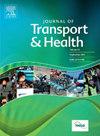Transportation insecurity in older adults aged 60 and older in Clark County, Nevada
IF 3.3
3区 工程技术
Q2 PUBLIC, ENVIRONMENTAL & OCCUPATIONAL HEALTH
引用次数: 0
Abstract
Introduction
With the growing aging population, ensuring that communities are age-friendly and address older adults' health, social, and economic needs is a public health priority. Transportation insecurity is associated with various aspects of individuals’ lives, affecting overall health and well-being, the ability to live independently, and adequately participate in society. The purpose of this study was to understand the prevalence and correlates of transportation insecurity among older adults aged 60 and older residing in Clark County, NV.
Methodology
Using a quantitative, cross-sectional design, researchers conducted phone surveys with a 24.58 % response rate using random-digit dialing and speaking directly to the older adult. Transportation insecurity was measured using the Sixteen-Item Transportation Security Index; other correlates known to be associated with barriers to transportation included race, ethnicity, age, gender, educational attainment, income level, marital status, disability status, and household characteristics.
Results
Of the 1001 participants, 25.3 % experienced transportation insecurity; 6.1 % experienced marginal transportation insecurity, 6.7 % experienced low transportation insecurity, 5.0 % experienced moderate transportation insecurity, and 7.5 % experienced high transportation insecurity. A logistic regression model (ꭔ2 = 167.330, df = 1, p = <0.001) showed transportation insecurity was associated with income, age, and disability status.
Conclusions
Results highlight the need for transportation equity and public health policy. Interventions aimed at particularly vulnerable groups, namely low income and older adults with disabilities, could help to alleviate disparities and improve access to essential services.
内华达州克拉克县60岁及以上老年人的交通不安全状况
随着人口老龄化的不断增长,确保社区对老年人友好并满足老年人的健康、社会和经济需求是公共卫生的优先事项。交通不安全与个人生活的各个方面有关,影响整体健康和福祉,独立生活和充分参与社会的能力。本研究的目的是了解居住在内华达州克拉克县的60岁及以上的老年人中交通不安全的患病率及其相关因素。方法采用定量、横断面设计,研究人员使用随机数字拨号和直接与老年人交谈进行电话调查,回应率为24.58%。运输不安全程度采用16项运输安全指数来衡量;其他已知与交通障碍相关的因素包括种族、民族、年龄、性别、受教育程度、收入水平、婚姻状况、残疾状况和家庭特征。结果在1001名参与者中,25.3%的人经历过交通不安全;6.1%的人经历了边缘运输不安全,6.7%的人经历了低运输不安全,5.0%的人经历了中度运输不安全,7.5%的人经历了高度运输不安全。logistic回归模型(ꭔ2 = 167.330,df = 1, p = <0.001)显示交通不安全与收入、年龄和残疾状况相关。结论交通公平和公共卫生政策的必要性。针对特别脆弱群体,即低收入和残疾老年人的干预措施可以帮助缩小差距,改善获得基本服务的机会。
本文章由计算机程序翻译,如有差异,请以英文原文为准。
求助全文
约1分钟内获得全文
求助全文

 求助内容:
求助内容: 应助结果提醒方式:
应助结果提醒方式:


